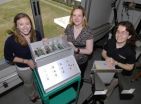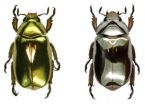(Press-News.org) Walking and thinking at the same time can be especially difficult for persons who've suffered concussions, and scientists hope to use that multitasking challenge -- measured by a simple radar system -- to quickly screen individuals who may have suffered brain injuries.
By asking an individual to walk a short distance while saying the months of the year in reverse order, researchers at the Georgia Tech Research Institute (GTRI) can determine if that person is impaired and possibly suffering from a concussion. This simple test, which could be performed on the sideline of a sporting event or on a battlefield, has the potential to help coaches and commanders decide if athletes and soldiers are ready to engage in activity again.
"When a person with a concussion performs cognitive and motor skill tasks simultaneously, they have a different gait pattern than a healthy individual, and we can identify those anomalies in a person's walk with radar," said GTRI research engineer Jennifer Palmer.
More than 1 million concussions and other mild traumatic brain injuries are reported each year in the United States and catching them right after they happen can improve treatment and prevent further injury or other long-term health issues. Diagnosing concussions can be difficult, though, because the symptoms of concussions are not always easily visible or detectable, even though they last for weeks or months following the incident. Methods exist for detecting concussions, but most focus purely on cognitive impairment and do not assess accompanying motor skill deterioration.
Details of GTRI's technique, which simultaneously examines a person's cognitive and motor skills, will be presented on April 26 at the SPIE Defense, Security and Sensing conference in Orlando. GTRI research engineers Kristin Bing and Amy Sharma, principal research scientist (ret) Eugene Greneker, and research scientist Teresa Selee also worked on this project, which is supported by the GTRI Independent Research and Development (IRAD) program.
Several studies have shown that measuring changes in gait could be used to diagnose concussions, but measuring a person's gait typically requires wearing special clothing with reflective markers or sensors so that movements can be captured with motion analysis cameras. Using radar for gait analysis would be faster and less intrusive than these existing techniques. The assessment would be done with radar systems similar to those used by police for measuring the speed of vehicles.
For their study, the GTRI research team compared how 10 healthy individuals walked normally and when impaired. For the impairment scenario, individuals wore goggles that simulated alcohol impairment. Past research has shown that concussion impairment is equivalent to having a blood alcohol level of 0.05 percent.
During the trials, each individual performed four 30-second walking tasks: a normal walk, walk while saying the months of the year in reverse order, walk while wearing the goggles, and walk while wearing the goggles and performing the cognitive task. For each task, the subjects walked away from the radar system, turned around and walked back toward the radar system.
"We're using a 10.5 gigahertz continuous wave radar, which is similar to a police officer's radar gun that measures the speed of a car," explained Bing. "The data we collect tells us the velocity of everything that's in the field of view of the radar at that time, including a person's foot kicks, and head and torso movements."
The researchers analyzed the radar data using information-theoretic techniques, which detected similarities and differences in the information without having to identify and align specific body parts. In addition, these techniques could recognize a gait anomaly without requiring that an individual's normal gait be measured before the person became impaired.
"By looking for differences in the gait patterns of normal and impaired individuals, we found that healthy individuals could be distinguished from impaired individuals wearing the goggles," explained Palmer. "Healthy individuals demonstrated a more periodic gait with regular and higher velocity foot kicks and faster torso and head movement than impaired individuals when completing a cognitive task."
The results also indicated that if no cognitive task was performed, a healthy individual's gait pattern was not statistically different when wearing and not wearing the goggles.
"We found that we needed to examine a person's physical and mental capabilities at the same time to see a change in gait and detect impairment," said Bing. "It's easy for a person to concentrate on one task, but when that person has to multitask we can begin to discriminate between someone who is impaired and someone who is not."
In the future, the researchers plan to collect additional data from healthy individuals of different heights and weights, and from individuals exhibiting concussion symptoms according to neuropsychological screening tests performed at a hospital. They also plan to reduce the size of the system so that it becomes more practical to use.
"For the military, we envision the system could fit into a tough box so that commanders can have it in the field," added Bing. "They could simply press a button, connect the radar system to a laptop, and an easy-to-use interface would display the results and tell them whether their soldier is exhibiting signs of a concussion."
Approval from the Food and Drug Administration will be required before this system can be used to diagnose concussions.
INFORMATION:
Radar shows promise for detecting concussions in athletes and soldiers
2011-04-26
ELSE PRESS RELEASES FROM THIS DATE:
IntelliVocab 1.5 Released to Improve English Vocabulary Interactively
2011-04-26
Faqden Labs is pleased to announce IntelliVocab 1.5 (formerly PowerVocab), an application for iOS devices which personalizes the English vocabulary learning for competitive exams and personal improvement.
Being designed by students of MIT, IntelliVocab 1.5 is based on the latest research from MIT Computer Science and Web Semantics Lab allowing users to master English vocabulary in the most effective way.
IntelliVocab completely controls the learning environment, so that users do not have to plan the learning approach. All they need to do is interact. Powerful enough ...
New perspectives on ion selectivity
2011-04-26
The latest Perspectives in General Physiology series examines the ion selectivity of cation-selective channels and transporters. The series appears in the May 2011 issue of the Journal of General Physiology (www.jgp.org).
According to Perspectives Editor Olaf Andersen in his introduction, a key tool in most recent studies on ion selectivity has been the so-called "toy models," which emphasize the fluid-like features of the selectivity filter and allow for the isolation of key features. Although proteins may indeed be fluid-like at small-length scales, however, they show ...
Cyara Solutions Continues Expansion into EMEA to Meet Growing Demand for a Better Contact Center Experience.
2011-04-26
Cyara, a pioneer of next-generation solutions for simulating, testing and monitoring interactive voice response (IVRs) and contact center systems, today announced further expansion into Europe, Middle East and Africa (EMEA) with the opening of a dedicated EMEA office headquartered in London. The company also announced the opening of a United Kingdom-based data center and appointed Nick Duggan as director of sales EMEA to develop and support its rapidly expanding customer base in the region which includes Vodafone, Sky and Nationwide Building Society.
The Cyara Solution ...
ACC/AHA issue first clinical guidance for controlling high blood pressure in the elderly
2011-04-26
Hypertension is very common among older adults. 64 percent of older men and 78 percent of older women have high blood pressure, placing them at heightened risk for heart disease including heart failure, stroke, coronary artery disease and atrial fibrillation, as well as chronic kidney disease and diabetes mellitus. Despite its prevalence, rates of blood pressure control remain substantially lower in the elderly than in younger patients. In fact, over age 80, only one in three men and one in four women have adequate control of their blood pressure. Faced with an aging patient ...
Protein levels could signal that a child will develop diabetes
2011-04-26
AUGUSTA, Ga. – Decreasing blood levels of a protein that helps control inflammation may be a red flag that could help children avoid type 1 diabetes, researchers say.
Georgia Health Sciences University researchers are looking at blood levels of interleukin-1 receptor antagonist, or IL-1ra, in children being closely followed because their genes put them at risk for type 1 diabetes. They also are looking at diabetic mice missing IL-1ra to see how the protein deficiency affects immune function and destruction of insulin-producing islet beta cells.
"We want to know if we ...
Researchers report widespread use of medications among pregnant women
2011-04-26
(Boston) – Researchers from Boston University's Slone Epidemiology Center, in collaboration with the Centers for Disease Control and Prevention (CDC) and Harvard School of Public Health, have reported widespread and increasing medication use among pregnant women. The study, which currently appears online in the American Journal of Obstetrics and Gynecology, also found that medication use varied by socioeconomic status, maternal age, race/ethnicity and state of residence.
Although a number of antenatal medication exposures are known to cause birth defects, there is insufficient ...
Conservation of coastal dunes is threatened by poorly designed infrastructure
2011-04-26
Although the dune ecosystem is unusual, fragile and is protected by the "habitats" directive of the network Natura 2000, its conservation is very vulnerable to the proliferation of car parks, nearby buildings and inadequate boardwalks installed for protection or beach access.
Researchers at the University of Seville (UoS) have published a study in the Journal of Coastal Research of human impact on the natural dunes at two sites in the Gulf of Cádiz, specifically in the protected areas of La Flecha Litoral in El Rompido and Enebrales in Punta Umbria, both in Huelva province. ...
Wild hogs: Researchers examine impact of feral pigs in eastern N.C.
2011-04-26
The nation's feral pig population continues to expand, increasing the potential for interaction with humans and domestic swine - and for spreading diseases. Researchers at North Carolina State University examined feral pigs from eastern North Carolina to determine exposure to two parasites that can be transmitted from animals to people – Toxoplasma gondii (T. gondii) and Trichinella.
The study found that wild pigs host a significant number of these parasites.
"If ingested by humans, these parasites can invade muscle tissue and organs, causing flu-like symptoms – with ...
Fighting HIV in South Africa should focus on couples, study finds
2011-04-26
PROVIDENCE, R.I. [Brown University] — A new study of sexual risk behaviors within long-term couples in South Africa finds that HIV-positive people take almost as much risk in their sexual behavior when they know their partner is HIV-negative or don't know their status, as when they know their partner is already infected. At the same time, HIV-positive partners who are on antiretroviral therapy and in intensive counseling do engage in less risky behavior. The Brown University researchers who led the study say both findings suggest that more couples-based HIV counseling is ...
Beetle bling: Researchers discover optical secrets of 'metallic' beetles
2011-04-26
WASHINGTON, April 25—Costa Rica was once regarded as the poorest of all the colonies of the Spanish Empire, sadly deficient in the silver and gold so coveted by conquistadors. As it turns out, all of the glittering gold and silver those explorers could have ever wanted was there all along, in the country's tropical rainforests—but in the form of two gloriously lustrous species of beetle.
Today, the brilliant gold- (Chrysina aurigans) and silver-colored (Chrysina limbata) beetles have given optics researchers new insights into the way biology can recreate the appearance ...




